New South Wales XPT
The New South Wales XPT (short for Express Passenger Train) is the main long-distance passenger train operated by NSW TrainLink on regional railway services in New South Wales, Australia from Sydney to Dubbo, Grafton and Casino as well as interstate destinations, Brisbane, and Melbourne. The XPT is based on the British Rail designed High Speed Train and entered service in April 1982.
| XPT | |
|---|---|
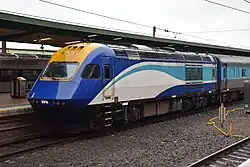 An XPT at Central railway station | |
| In service | 8 April 1982 |
| Manufacturer | Comeng ABB Transportation |
| Built at | Granville Dandenong |
| Family name | High Speed Train |
| Entered service | 1981–1994 |
| Refurbished | 1992–1993, 2005–2008 |
| Number built | 19 power cars 60 passenger carriages |
| Formation | 2 power cars, 4–7 carriages |
| Fleet numbers | XP2000-18, XFH2104-10, XFH2112-13, XBR2150-58, XAM 2175-82 XF2200-24, XL2228-36 |
| Operator(s) | NSW TrainLink |
| Depot(s) | XPT Service Centre |
| Line(s) served | North Coast Main Western Main Southern |
| Specifications | |
| Maximum speed | Service: 160 km/h (100 mph),[1] Record: 193 km/h (120 mph) |
| Traction system | DMU |
| Prime mover(s) | Paxman Valenta (as built) Paxman VP185 (from 2000) |
| Engine type | Both V12 diesel |
| Cylinder count | 12 |
| Power output | 1,492 kW (2,001 hp) per power car |
| Transmission | Diesel-electric |
| Bogies | PJA (Power) NJA (Trailer) |
| Coupling system | Knuckle |
| Track gauge | 1,435 mm (4 ft 8 1⁄2 in) standard gauge |
History
Development
Improving public transport was a major issue in the 1976 State Election in New South Wales and one of the commitments of the incoming Wran Government was to buy new rolling stock for country rail services.
In January 1978, the Public Transport Commission invited tenders for 25 high-speed railcars similar to the Prospector railcars delivered by Comeng to the Western Australian Government Railways in 1971. The tender allowed bidders to suggest alternative types of high-speed train. Comeng submitted a tender for a train based on the British Rail designed High Speed Train which had entered service in the United Kingdom in October 1976. In August 1979, Comeng was announced as the successful bidder and although the tender had called for 100 vehicles, by the time the contract was signed in March 1980, the order was only for 30, 10 power cars and 20 carriages, enough to form four five-carriage trains with two spare power cars.[2][3][4][5][6][7]
The High Speed Train design was significantly modified, with the power cars being 50 cm (19.7 in) shorter, the Paxman Valenta engine downrated from 2,250 to 2,000 bhp (1,680 to 1,490 kW), gearing lowered for a top operating speed of 160 km/h (99 mph), suspension modified to operate on inferior track, and air filters and the cooling system modified to cater for hotter and dustier Australian conditions. However, the XPT is theoretically capable of reaching speeds of 200 km/h (120 mph).[8] A different light cluster was fitted along with three high-beam spotlights mounted to the roof. The passenger trailer cars were based on a Budd design, with the British Rail Mark 3 trailers considered unsuitable.[5]
In service
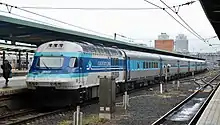
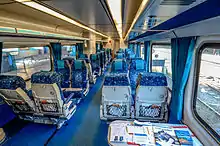
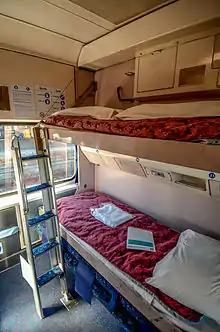


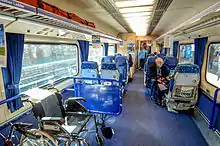
The first power car and trailer commenced testing with a stainless steel luggage van in August 1981.[9] The initial XPT livery was red, black and orange with InterCity XPT signwriting on the power cars. It was also known as the "Supertrain".[10] On a demonstration run to Albury on 6 September 1981 the XPT set a new Australian speed record of 183 km/h between Table Top and Gerogery in southern NSW, breaking that set by the Western Australian Government Railways' Prospector railcar in 1971. On a test run to Albury on 18 September 1992 the XPT reached 193 km/h between Table Top and Yerong Creek.[11] 200 km/h was the target speed.[12] This record was broken by Queensland Rail's Electric Tilt Train in May 1999.[13]
The first full test XPT set ran in January 1982. The four sets entered service on the Central West XPT to Dubbo in April 1982, the Mid North Coast XPT to Kempsey in May 1982 and the Riverina XPT to Albury in August 1982.[5]
In 1983, a further five power cars and 15 trailers were ordered. These allowed the Canberra XPT to commence in August 1983 followed by the Northern Tablelands XPT to Glen Innes and Tenterfield (2 times per week only) in June 1984.[14] The XPT cut 50 minutes off the trip between Sydney and Canberra.[15] By tightening up the diagrams, an overnight South XPT to Albury was introduced, but cancelled in June 1985 due to low patronage.[16][17][18] In 1985 an additional 12 trailer carriages were ordered to allow six sets of 7 carriages to be formed.[19][20] From October 1985, the Mid North Coast XPT to Kempsey ceased, being replaced by the Holiday Coast XPT to Grafton. The Northern Tablelands XPT also was cut back to Armidale and only ran on alternate days with a HUB/RUB set operating on the other days.[21]
Initially the XPT carried a fare surcharge compared to parallel locomotive hauled services; however this was abolished from May 1985.[22]
It was proposed to extend operations to Melbourne with costs to be shared with V/Line. A promotional train ran to Melbourne in November 1990, with the consist XP2012-XDH2111-XDR2156-XD2219-XD2215-XFH2015-XP2008.[23] Further demonstration runs took place to Melbourne in February 1985.[24] Crew training commenced on the North East line between Albury and Benalla in July 1985 with services scheduled to commence on 3 August, however agreement could not be reached with the Australian Federated Union of Locomotive Employees over crewing and the plan was shelved.[25][26][27]
Following the election of the Greiner Government in March 1988, consultants Booz Allen Hamilton were commissioned to prepare a report into NSW rail services. On purely economic grounds, the report recommended closing all country passenger services as they were judged unviable; however this was not politically acceptable.[28] If services were to be maintained, the report recommended operating a reduced rail service, all with XPTs.
In February 1990, the Brisbane Limited and Pacific Coast Motorail were withdrawn and replaced by XPT services to Brisbane and Murwillumbah. To provide rolling stock for these, the Canberra XPT was withdrawn and replaced by a locomotive hauled train and the Northern Tablelands Express was truncated to become a day return service to Tamworth.[29][30]
In June 1990, the government announced that it would purchase a fleet of Xplorers to reintroduce services to Armidale and Moree. When these were introduced in October 1993 the Northern Tablelands XPT ceased and the stock replaced a locomotive hauled set on a service to Grafton.[31]
In October 1990, the government announced that eight sleeper carriages would be ordered for use on overnight services to Brisbane, Murwillumbah and Melbourne.[32][33] These were included in an order placed with ABB Transportation, Dandenong in 1991 for four power cars and 13 trailers that was jointly funded by the New South Wales and Victorian governments.[34][35][36][37] At the same time the earlier stock was repainted in CountryLink livery.[38]
In November 1993, XPTs replaced locomotive hauled stock on the overnight Sydney/Melbourne Express.[39] In December 1994 an XPT daylight service to Melbourne was introduced by extending the Riverina XPT from Albury.[40]
In 1995, CountryLink trialled three Swedish Railways X2000 tilting train carriages. After conducting a statewide tour in March, they were used on Canberra services from 23 April until 18 June 1995 with modified XPT power cars XP2000 and XP2009.[41]
Since 2003, an XPT has operated a service each January to Parkes for the Parkes Elvis Festival.[42][43] With the closure of the Murwillumbah line, the XPT service was cut back to Casino from May 2004.[44][45] In October 2013, with a set isolated west of Lithgow by bushfires, it was deployed on the Outback Xplorer service to Broken Hill.[46]
Accidents and incidents
On 3 May 1991, an XPT locomotive derailed at Henty near the New South Wales-Victorian border, injuring the driver and six passengers.[47]
On 27 January 2001, an XPT collided with a car on a level crossing at Gerogery, New South Wales. Five people in the car were killed, and the train was derailed.[48]
On 20 February 2020, a Sydney to Melbourne bound XPT derailed at around 7:45 pm near Wallan, Victoria, killing the train's driver and pilot and injuring twelve.[49][50]
Services
The XPT fleet is currently used on services from Sydney to Dubbo, Grafton, Casino, Brisbane and Melbourne.[57][58][59]
Operating cycle
The Dubbo set is captive and operates a daily return service. The other seven sets rotate on a seven-day repeating cycle as follows:[60]
- Day 1: 07:42 Sydney to Melbourne arrives 18:30, forms 19:50 Melbourne to Sydney
- Day 2: arrives Sydney 06:58, forms 11:41 Sydney to Grafton arrives 22:15
- Day 3: 05:15 Grafton to Sydney arrives 15:45, forms 20:42 to Melbourne
- Day 4: arrives in Melbourne 07:30, forms 08:30 to Sydney arrives 19:59
- Day 5: 07:08 Sydney to Casino arrives 18:41, forms 19:30 Casino to Sydney
- Day 6: arrives Sydney 07:01, forms 14:41 Sydney to Brisbane
- Day 7: arrives Brisbane 04:53, forms 05:55 Brisbane to Sydney arrives 20:10
Between each duty in Sydney, trains are serviced at the XPT Service Centre south of Sydenham station. This pattern has led to the XPT being one of the most utilised train fleets worldwide with only three significant periods of downtime in the cycle. This includes one overnight stabling in Grafton, between days 2 and 3, and two overnight stablings in Sydney, between days 4 and 5, and days 7 and 1.
As at 26 June 2020, the 1141 hours Sydney to Grafton daily XPT and 1930 hours overnight Casino - Sydney XPT were continually replaced by road coaches due to reduced availability of XPT power car, partly due to XP2018 requiring repairs aftermath of the Wallan derailment of 20 February 2020.
Formations
Initially all services operated with five carriage sets. Following the purchase of extra carriages, this was increased to seven. In 1998 each set was reduced to six carriages.[61] In 2001 all were reduced to five carriages outside of school holiday periods.[62][63] Today XPTs operate with four carriages to Dubbo (formed from the country end as XL, XBR, XF and XFH), and five (formed from the country end as XAM, XL, XBR, XF and XFH) on the North Coast and Melbourne services, with six during peak times when an extra XF is added. The Dubbo set can operate with one power car if required, with the power car turned at its destination.
Fleet
The XPT fleet consists of:
- 19 XP Power cars
- 8 XAM Sleeping cars
- 9 XL First class saloon cars
- 9 XBR First class saloon/buffet cars
- 25 XF Economy class saloon cars
- 9 XFH Economy class saloon/luggage cars
Power cars
XPT power cars originally powered by a Paxman Valenta 12RP200L engine with a single turbocharger. These were replaced from June 2000 by Paxman VP185 12-cylinder, diesel engines with four low-pressure turbochargers and two high-pressure turbochargers boasting 1,492 kW or 2,001 horsepower that had been successfully used by some British Rail High Speed Trains since 1994.[64][65] Traction equipment was manufactured in England by Brush Traction of Loughborough.
Power cars comprise five main compartments at the platform level. At the front is the drivers' cab, followed by the clean air compartment, engine room, cooling group, and compressor room at the rear of the locomotive.
The State Rail Authority named the XP power cars after destinations that the XPT served. All nameplates have since been removed.
These were:
- XP2000 – City of Maitland
- XP2001 – City of Dubbo
- XP2002 – City of Brisbane
- XP2003 – City of Orange
- XP2004 – City of Kempsey
- XP2005 – City of Newcastle
- XP2006 – City of Wagga Wagga
- XP2007 – City of Albury
- XP2008 – City of Goulburn
- XP2009 – City of Murwillumbah
- XP2010 – City of Taree
- XP2011 – City of Sydney
- XP2012 – City of Tamworth
- XP2013 – City of Casino
- XP2014 – City of Grafton
- XP2015 – City of Wangaratta
- XP2016 – City of Cootamundra
- XP2017 – City of Melbourne
- XP2018 – City of Coffs Harbour
XP2000-XP2014 were built by Comeng, Granville with XP2015 – XP2018 built by ABB Transportation, Dandenong.
XPT power cars have dimensions of 17.30 metres (56 ft 9 1⁄8 in) long, 2.89 metres (9 ft 5 3⁄4 in) wide and 4.03 metres (13 ft 2 5⁄8 in) high. They weigh 76 tonnes (75 long tons; 84 short tons) with two operating on each service in a push pull arrangement.
.jpg.webp)
Carriages
The original XPT carriages were refurbished in 1992/93 including a repaint in CountryLink livery.[38] All were refurbished again between 2005 and 2008.[66][67][68][69]
Carriage coding, features and numbers are as follows:
| Type | Services Provided | Number in fleet | Seating Capacity | Weight (tonnes) | ID Number and constructor | Notes |
| XFH | Economy Saloon, Booked Luggage Compartment, Guard's Compartment |
9 | 44 | 40.1 | XFH 2104 – XFH 2110, XFH 2112 and XFH 2113 (Comeng) |
|
| XF | Economy Saloon | 25 | 68 | 40.1 | XF 2200 – XF 2224 (Comeng) |
|
| XBR | First Class Saloon, Buffet/Cafe |
9 | 21 (plus one wheelchair space) | 43.6 | XBR 2150 – XBR 2158 (Comeng) |
XBR 2157 was rebuilt from economy class saloon XD 2225 and XBR 2158 from economy saloon/luggage car XDH 2111, both by United Goninan, Broadmeadow |
| XL | First Class Saloon | 9 | 56 | 40.1 (Comeng) 39.6 (ABB Transportation) |
XL 2228 – XL 2232 (ABB Transportation) XL 2233 – XL 2236 (Comeng) |
XL 2233 – 2236 were rebuilt by United Goninan from XFH/XDH saloon/luggage cars |
| XAM | First Class corridor car, Guard's Compartment |
8 | 18 sleeping 27 seated |
48.3 | XAM 2175 – XAM 2182 (ABB Transportation) | Nine passenger compartments available as twin-berth sleepers for overnight services or three-seat "daysitters" at other times, with five shared toilet/shower compartments. |
The XPT fleet is maintained at the XPT Service Centre, a purpose built depot south of Sydenham station within the confines of the Meeks Road Triangle. All work is performed here except for wheel reprofiling which is performed on a wheel lathe at Flemington Maintenance Depot.
Potential export sale
In 1986, agreement was reached to build a fleet of XPTs for the State Railway of Thailand. To allow it to be built to the narrower 1,000 mm (3 ft 3 3⁄8 in) metre gauge and retain the same fuel capacity, it was proposed to extend the power cars by 2.7 metres to 20 metres and mount them on Bo-Bo-Bo bogies. The negotiations were sufficiently advanced for the Prime Minister of Thailand to announce it on television, however the Australian Department of Trade withdrew its support at the last moment and the deal fell through.[37][70][71]
References
- "Signal passed at danger by XPT ST24" (PDF). Australian Transport Safety Bureau. 26 June 2012. ISBN 978-1-74251-250-1. Retrieved 21 February 2020.
The XPT has a maximum permitted speed of 160 km/h (99 mph) depending on track condition and posted speed limits
- "New Trains for Country Services" Network March 1979 page 16
- "NSW gives country passengers a break" Railway Gazette International March 1979 page 210
- "HST begets XPT" Railway Gazette International June 1980 pages 511/512
- Cooke, David (1984). Railmotors and XPTs. Australian Railway Historical Society NSW Division. ISBN 0 909650 23 3.
- Marsden, Colin (2001). HST Silver Jubilee. Ian Allan Publishing. ISBN 0 711028 47 8.
- "XPT Australia's train of tomorrow" Rail Enthusiast September 1982 pages 40-42
- "To find out what the XPT can do". The Canberra Times. 13 June 1981.
- "Here & There" Australian Railway Historical Society Bulletin issue 528 October 1981 page 81
- "SYDNEY HARBOUR BRIDGE 50th ANNIVERSARY CELEBRATIONS". Main Roads. 47 (2): 44–52. June 1982.
- "The making of an XPT speed record" Railway Digest November 1992 page 417
- "XP Class frame". www.railmotorsociety.org.au. Retrieved 21 September 2017.
- "QR Tilt Train Sets Australian Rail Speed Record" Railway Digest June 1999 page 15
- "XPTs Take Over Northern Tablelands Express and South Mail" Railway Digest July 1984 page 222
- "Canberra XPT service". Canberra Times (ACT : 1926 – 1995). 3 February 1982. p. 1. Retrieved 24 March 2018.
- Union criticises axing of Sydney-Albury XPT Canberra Times 24 June 1985 page 3
- "Country Train and Coach Changes" Railway Digest August 1985 page 229
- "The XPT Turns 15" Railway Digest April 1997 page 43
- "XPT Cars Ordered" Railway Digest October 1985 page 297
- "In Brief" Railway Gazette International October 1985 page 737
- "More Timetable Changes" Railway Digest November 1985 page 327
- "XPT Fares Reduced" Railway Digest April 1985 page 98
- Newsrail March 1991 p68
- "XPT visit" Newsrail April 1985 page 115
- XPT Interstate Trains Canberra Times 16 July 1985 page 12
- "XPT Crew Training in Victoria" Newsrail October 1985 page 306
- "Two years late" Newsrail May 1986 page 146
- "CountryLink 2000" Railway Digest August 1989 page 262
- Canberra XPT can't be saved Canberra Times 24 January 1990 page 7
- "The New Timetable" Railway Digest March 1990 page 94
- "Xplorer Enters Service" Railway Digest November 1993 page 458
- "XPT sleepers for North Coast trains" Railway Digest November 1990 page 385
- "XPT revamp" Railway Gazette International November 1990 page 823
- "NSW/Vic to share XPTs" Railway Digest January 1991 page 7
- "Sydney-Melbourne to go XPT" Railway Gazette International January 1991 page 9
- "XPT trailer cars to be built in Victoria" Railway Digest August 1991 page 273
- Dunn, John (2013). Comeng: A History of Commonwealth Engineering Volume 5 1985–2012. Kenthurst: Rosenberg Publishing. pp. 13–15, 203–219. ISBN 9781922013521.
- "New Colours for Australia'a XPT" The Railway Magazine issue 1085 September 1991 page 607
- "Major Passenger Train Changes Commence this Month" Railway Digest November 1993 page 466
- "Sydney-Melbourne Daylight XPT Commences This Month" Railway Digest December 1994 page 7
- "So why do you call it a tilt train?" Railway Digest July 1995 page 30
- "Elvis Express" Railway Digest March 2006 page 57
- All aboard the NSW TrainLink Elvis Express train NSW Trains 8 January 2014
- "Murwillumbah XPT to end – line faces closure" Railway Digest June 2004 page 6
- Closure of the Casino to Murwillumbah rail service NSW Parliament 24 November 2004
- Australian Railways Illustrated December 2013 page 8
- "XPT locomotive derailed, driver, six passengers hurt". The Canberra Times. 5 May 1991. Retrieved 21 February 2020.
- "Riding a slow train to nowhere". The Sydney Morning Herald. 14 May 2014. Retrieved 20 February 2020.
- "Two people die after passenger train derails near Wallan north of Melbourne". ABC News. 20 February 2020. Retrieved 20 February 2020.
- "'It was horrendous': Derailed train passengers were tossed around in crash". The Sydney Morning Herald. Retrieved 20 February 2020.
- New NSW country fleet procurement to begin in 2017 Rail Express 31 October 2016
- NSW fleet replacement accelerated Railway Gazette International 31 October 2016
- First steps taken to deliver new XPT fleet Transport for NSW 1 March 2017
- Process kicks off to replace XPTs Rail Express 1 March 2017
- "Shortlist announced for NSW regional fleet renewal" International Railway Journal 4 December 2017
- CAF to replace New South Wales regional train fleet Railway Gazette International 14 February 2019
- Western timetable NSW TrainLink
- North Coast timetable NSW TrainLink
- Southern timetable NSW TrainLink
- "Xtra Precise Timing: Secrets of the XPT roster" Railway Digest April 2002 pages 20/21
- "Asian Downturn Hits CountryLink – XPTs Shed Cars" Railway Digest June 1998 page 9
- "Countrylink News – XPTs cut to five cars & Xplorers to Broken Hill?" Railway Digest June 2001 page 7
- "Here & There" Australian Railway Historical Society Bulletin issue 765 July 2001 page 273
- "MTU looks at IC125 power" Rail Business Intelligence issue 118 20 January 2000 page 6
- "Market" Railway Gazette International April 2000 page 210
- "Enhancements underway for CountryLink's XPT fleet" Railway Digest March 2005 page 6
- "XPT Passenger Cars new livery in service" Railway Digest February 2006 page 12
- "The CountryLink XPT Refurbishment" Railway Digest July 2006 pages 22–27
- "XPT carriage refurbishment completed" Railway Digest October 2008 page 9
- "Comeng poised to win deal" Newsrail October 1985 page 302
- "Thai train deal" Newsrail February 1986 page 52
External links
![]() Media related to XPT at Wikimedia Commons
Media related to XPT at Wikimedia Commons